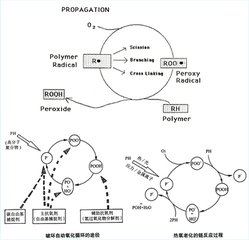抗氧化剂或成为潜在的帕金森疾病疗法
乔治亚健康科学大学的研究者研究报道,一种新型强大的抗氧化剂有一天将有可能成为治疗帕金森疾病的潜在药物。这种抗氧化剂为合成的三萜类化合物,可以阻止帕金森疾病的发展。相关研究成果刊登在Antioxidants & Redox Signaling上。
研究者Thomas和其同事使用抗氧化剂药物来支持Nrf2,从而可以阻止帕金森病人脑细胞中所产生的多巴胺的消失。Nrf2是氧化压力和炎症的主要调节子,可以明显降低早期的帕金森患者疾病进程,实际上Nrf2的活性随着年龄逐渐下降。在帕金森患者中,你可以看到其氧化性应激的负担,这就是为什么研究者选择这个靶点了。
文章中,研究者仔细分析了众多抗氧化剂,最终发现了三萜类化合物对Nrf2具有高的效应,在人神经母细胞瘤和小鼠大脑细胞中可以产生高水平的Nrf2来对三萜类化合物产生反应。起初的实验结果表明,合成类的三萜类化合物可以增加星形细胞的Nrf2的活性,药物不能保护大脑细胞。因此研究者使用神经毒素MPTP来模仿帕金森样大脑细胞,如今,研究者可以观察到合成的三萜类化合物可以程序化地使得帕金森疾病减缓,而且研究者也提供了诱导型的多能型干细胞,其可以慢慢形成多巴胺能神经元,为附加的药物检测做准备。
编译自:Powerful Class of Antioxidants May Be Potent Parkinson's Treatment
Targeting Nrf2-mediated gene transcription by extremely potent synthetic triterpenoids attenuate dopaminergic neurotoxicity in the MPTP- mouse model of Parkinson’s disease
Dr. Navneet Ammal Kaidery, Dr. Rebecca Banerjee, Dr. Lichuan Yang, Dr. Natalya A Smirnova, Dr. Dmitry M Hushpulian, Dr. Karen T Liby, Ms. Charlotte W Williams, Masayuki Yamamoto, Dr. Thomas W. Kensler, Prof. RAJIV RATAN, Prof. Michael B Sporn, Dr. Flint Beal, Dr. Irina G Gazaryan, and Dr. Bobby Thomas.
Although the etiology of Parkinson’s disease (PD) remains unclear, ample empirical evidence suggest oxidative stress is a major player in the development of PD and in 1-methyl-4-phenyl-1,2,3,6 tetrahydropyridine (MPTP)-neurotoxicity. Nuclear factor E2-related factor 2 (Nrf2) is a redox sensitive transcription factor which upregulates a battery of antioxidant response element (ARE) driven antioxidative and cytoprotective genes that defend against oxidative stress. Aims: We evaluated whether the strategy of activation of Nrf2 and its downstream network of cytoprotective genes with small molecule synthetic triterpenoids attenuate MPTP-induced PD in mice. Results: We show that synthetic triterpenoids are thus far the most potent and direct activators of the Nrf2 pathway using a novel Neh2-luciferase reporter. They upregulate several cytoprotective genes including those involved in glutathione biosynthesis in vitro. Oral administration of triterpenoids that were structurally modified to penetrate the brain induced mRNA and protein levels for a battery of Nrf2-dependent cytoprotective genes, reduced MPTP-induced oxidative stress and inflammation, and ameliorated dopaminergic neurotoxicity in mice. The neuroprotective effect of these triterpenoids against MPTP-neurotoxicity was dependent on Nrf2, since treatment with triterpenoids in Nrf2 knockout mice failed to block against MPTP-neurotoxicity and induce Nrf2-dependent cytoprotective genes. Innovation: Extremely potent synthetic triterpenoids that are direct activators of the Nrf2 pathway blocks dopaminergic neurodegeneration in the MPTP- mouse model of PD. Conclusion: Our results indicate that activation of Nrf2/ARE signaling by synthetic triterpenoids is directly associated with their neuroprotective effects against MPTP-neurotoxicity and suggest that targeting the Nrf2/ARE pathway is a promising approach for therapeutic intervention in PD.
 此主题相关图片如下:1.jpg
此主题相关图片如下:1.jpg